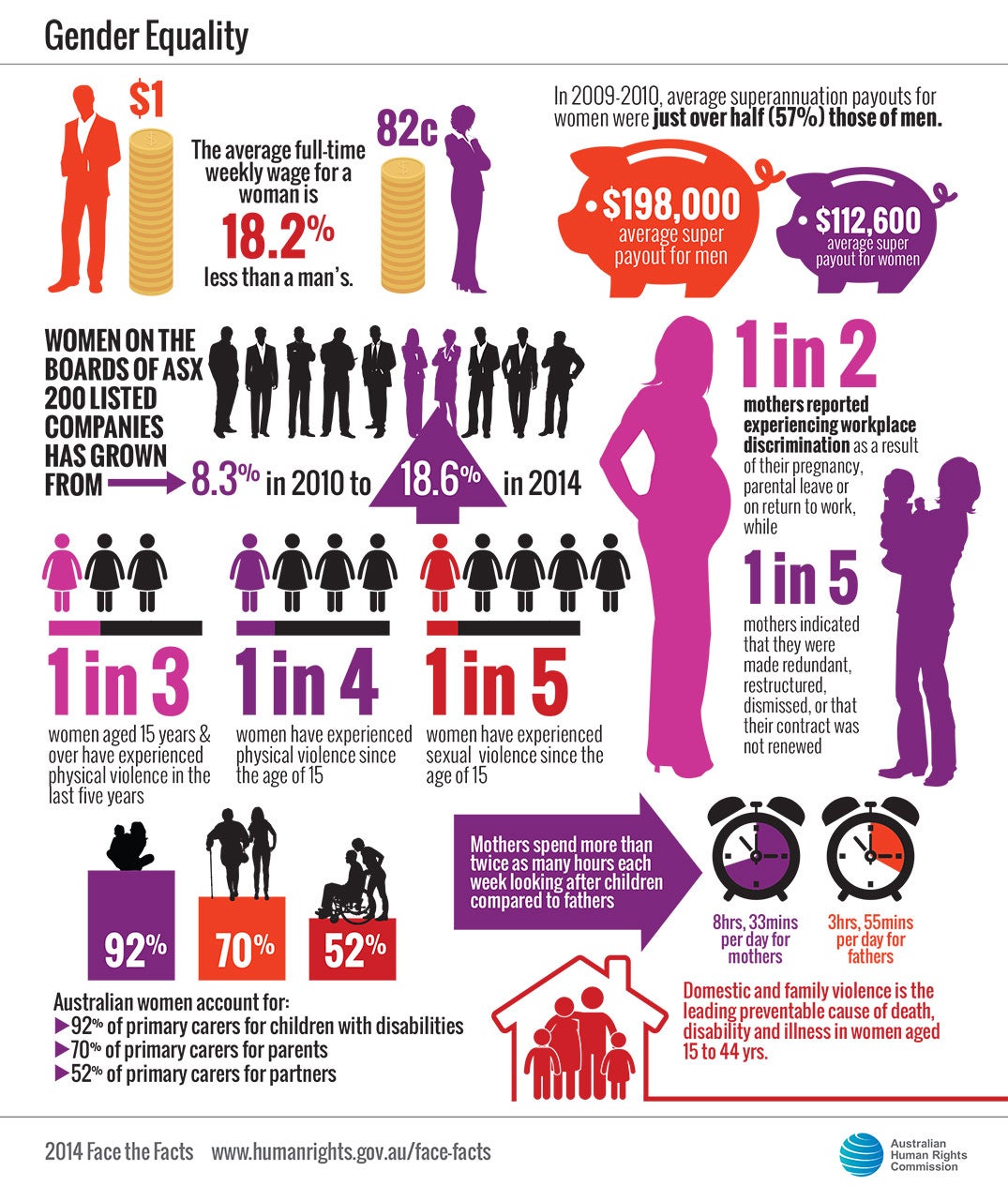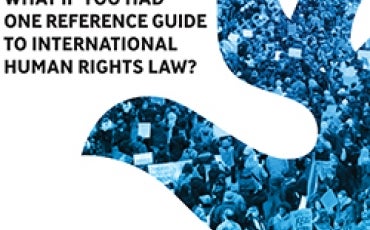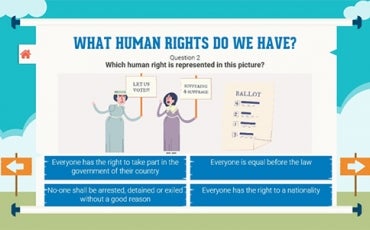Face the Facts - Gender Equality 2014
Statistics from 2014
Back to main Face the Facts page
 In 1984, the Sex Discrimination Act came into force, making it against the law discrimination to discriminate against someone on the basis of gender, sexuality, marital status, family responsibilities or because they are pregnant.
In 1984, the Sex Discrimination Act came into force, making it against the law discrimination to discriminate against someone on the basis of gender, sexuality, marital status, family responsibilities or because they are pregnant.
The Act, which gives effect to Australia’s international human rights obligations under the Convention on the Elimination of All Forms of Discrimination against Women, has played an important role in changing community attitudes and helping advance gender equality in this country.
Despite this progress, women and girls continue to experience inequality and discrimination in many important parts of their lives, which can limit the choices and opportunities available to them.
About gender equality in Australia
- Women and girls make up just over half (50.2 per cent) of the Australian population.[1]
- While women comprise roughly 46 per cent of all employees in Australia,[2] they take home on average $283.20 less than men each week (full-time adult ordinary time earnings)[3]. The national gender “pay gap” is 18.2 per cent and it has remained stuck between 15 per cent and 18 per cent for the past two decades.[4]
- Australian women account for 92 per cent of primary carers for children with disabilities, 70 per cent of primary carers for parents and 52 per cent of primary carers for partners.[5]
- In 2013, Australia was ranked 24th on a global index measuring gender equality, slipping from a high point of 15th in 2006.[6]
Barriers to gender equality
- [7]Australian women are over-represented as part-time workers in low-paid industries[8] and in insecure work and continue to be underrepresented in leadership roles in the private and public sectors.[9]
- A quarter of women were sexually harassed in the workplace between 2007 and 2012.[10] The harasser was most likely to be a co-worker (52 per cent) and the most common forms of sexual harassment included sexually suggestive comments/jokes (55 per cent), intrusive questions about private life or appearance (50 per cent) and inappropriate staring or leering (31 per cent).[11]
- In 2014, one in two (49 per cent) mothers reported experiencing discrimination in the workplace at some point during pregnancy, parental leave or on return to work, and one in five (18 per cent) mothers indicated that they were made redundant, restructured, dismissed, or that their contract was not renewed because of their pregnancy, when they requested or took parental leave, or when they returned to work.[12]
- Mothers spend twice as many hours (8 hours and 33 minutes) each week looking after children under 15, compared to fathers (3 hours and 55 minutes). [13]
- In 2009-2010, average superannuation payouts for women were just over half (57%) those of men. Average retirement payouts in 2009-10 were of the order of $198,000 for men and only $112,600 for women. [14] As a result, women are more likely to experience poverty in their retirement years and be far more reliant on the Age Pension.[15]
- One in three Australian women aged 15 years and over has experienced physical violence[16] and nearly one in five has experienced sexual assault.[17] It is estimated that violence against women and children will cost the Australian economy $15.6 billion per year by 2021-2022 unless decisive action is taken to prevent it.[18]
- More than smoking or obesity, domestic and family violence is the leading preventable cause of death, disability and illness in women aged 15 to 44 years.[19]
Positive developments
- The percentage of women on the Boards of ASX 200 listed companies has grown from 8.3 per cent in 2010 to 18.6% per cent in August 2014.[20]
- Australian men and women overwhelmingly believe (90 per cent) that men should be as involved in parenting as women.[21]
- Since 2013, over one million Australian workers are able to take leave and enjoy other protections because of domestic violence clauses in their workplace agreement or award conditions.[22]
Did you know?
- The average Australian woman has to work an extra 66 days a year to earn the same pay as the average man. [23]
Our role
The Commission helps people resolve complaints of unfair treatment under the Sex Discrimination Act, including discrimination on the basis of sex, marital (or relationship) status and pregnancy and potential pregnancy. The Act also protects workers with family responsibilities and makes sexual harassment against the law.
The Sex Discrimination Commissioner works in partnership with a broad range of groups to promote gender equality and counter discrimination, sexual harassment, violence against women and other barriers to gender equality. She also undertakes major research projects and provides policy advice to government and others to bring about positive change.
Find out more about our work in this area.
Find out more
- Australian Human Rights Commission, Supporting Working Parents: Pregnancy and Return to Work National Review (2014)
- Australian Human Rights Commission, Investing in care: recognising and valuing those who care (2013)
- Australian Human Rights Commission, Working without fear: Results of the Sexual Harassment National Telephone Survey (2012)
- Australian Human Rights Commission, Australian study tour report: Visit of the UN Special Rapporteur on violence against women (2012)
- Australian Human Rights Commission, Know Your Rights: Sex discrimination and sexual harassment (2012)
- Australian Human Rights Commission, Gender Equality Blueprint 2010 (2010)
- Australian Bureau of Statistics, 4436.0 - Caring in the Community, 2012 (June 2014)
- Australian Bureau of Statistics, 4125.0 - Gender Indicators - Australia, 2014 (August 2014)
- Workplace Gender Equality Agency, Gender pay gap statistics (August 2014)
- Workplace Gender Equality Agency; Gender workplace statistics at a glance (December 2014)
- World Economic Forum, Global Gender Gap Report 2014 (2014)
- United Nations, Convention on the Elimination of Discrimination against Women
[1] Australian Bureau of Statistics, 3201.0-Population by Age and Sex, Australian States and Territories, June 2009, (December 2009).
[2] Workplace Gender Equality Agency, Gender workplace statistics at a glance (December 2014) p 1.
[3] Workplace Gender Equality Agency, Gender pay gap statistics (March 2014) p 2.
[4] Workplace Gender Equality Agency, above, p 2.
[5] Australian Bureau of Statistics, 4153.0-How Australians Use Their Time, 2006 (February 2008).
[6] World Economic Forum, Global Gender Gap Report 2013 (2013) pp 8-9.
Women in male-dominated industries: A toolkit of strategies (2013), p 3.
[8] For example approximately 45 per cent of women in the workforce are employed part-time compared with around 16 per cent of men. See: Australian Bureau of Statistics, 6202.0-Labour Force, Australia, Table 03: Labour force status by sex (September 2009).
[9] For example, in 2012 women held only seven CEO positions and made up only 10.1 per cent of executive management positions in ASX 200 companies (see: Workplace Gender Equality Agency, Australian Census of Women in Leadership 2012 (2012) and, despite making up more than half of all Commonwealth public servants, they comprise only 39.6% of the Senior Executive Service (see: Australian Public Service Commission, State of the Service Report 2013-14 (2014), p 71).
[10] Australian Human Rights Commission, Working without fear: Results of the Sexual Harassment National Telephone Survey (2012), p 4.
[11] Australian Human Rights Commission, above, p 4.
[12] Australian Human Rights Commission, National Review on Discrimination Related to Pregnancy, Parental Leave and Return to Work (2014) pp 4-5.
[13] Australian Bureau of Statistics, 4125.0 - Gender Indicators, Australia, Jan 2012: Caring for Children (February 2012).
[14] R Clare, Developments in the level and distribution of retirement savings (2011), pp 10-11.
[15] R Tanton, Y Vidyattama, J McNamara, Q Ngu Vu & A Harding, Old Single and Poor: Using Microsimulation and Microdata to Analyse Poverty and the Impact of Policy Change Among Older Australians (2008) p 15.
[16] Australian Bureau of Statistics, 4906.0 - Personal Safety, Australia, 2005 (Reissue) (August 2006).
[17] Australian Bureau of Statistics, above.
[18] The National Council to Reduce Violence against Women and their Children, The cost of violence against women and their children (March 2009), p 4.
[19] Victorian Health Promotion Foundation (VicHealth), The health costs of violence: Measuring the burden of disease caused by intimate partner violence (2004), p 8.
[20] Australian Institute of Company Directors, Appointments to ASX 200 Boards (viewed at 15 September 2014).
[21] A Evans and E Gray, ‘What makes an Australian family?’ in S Wilson, G Meagher, R Gibson, D Denemark & M Western (eds), Australian Social Attitudes: The first report (2005), pp 12–29, p 27.
[22] L McFerran, Safe at Home, Safe At Work Project, Australian Domestic and Family Violence Clearing House, UNSW, ‘When domestic violence becomes a workplace problem’, ABC The Drum Opinion 13 February 2013.
[23] Workplace Gender Equality Agency, Gender Pay Gap Statistics 2014 note 3, p 4.



